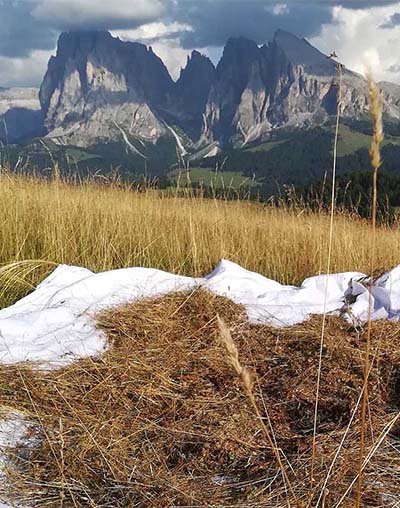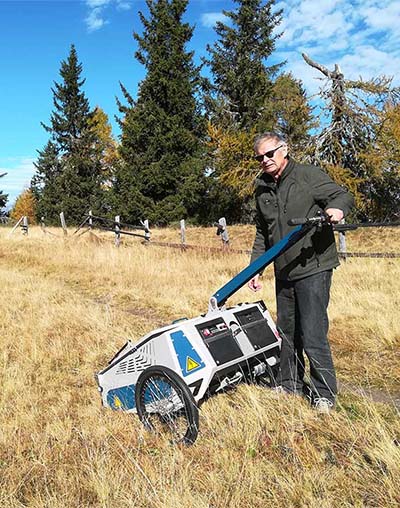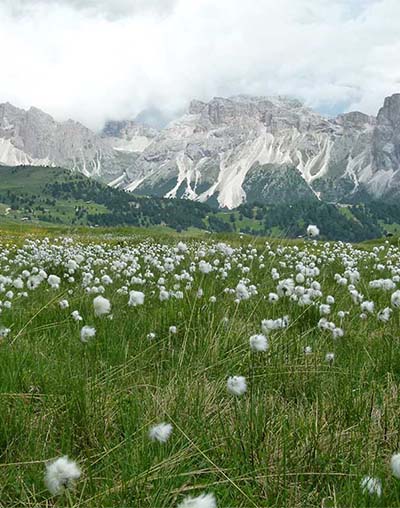Pubblicazioni e links in tema di sementi autoctone, ecotipi e rinverdimenti naturalistici
Schenkenberger J. (2019): Pioniere für die lokale Artenvielfalt: Saatgutgewinnung aus Naturwiesen. Naturschutz und Landschaftsplanung 12/19, 600-603.
Durka W. et al. (2019): Regionales Saatgut von Wiesenpflanzen: genetische Unterschiede, regionale Anpassung und Interaktion mit Insekten. Natur und Landschaft 94/4, 146-153.
M. Scotton (2019): Mountain grassland restoration: Effects of sowing rate, climate and soil on plant density and cover. Science of the Total Environment 651: Jonas3090–3098.
Hänggi Basler Landschaftsarchitektur GmbH (2018): Naturparadies Wohnsiedlung Bellevuepark Port (Biel/BE): Über 10 000 m2 naturnah gestaltete Grünflächen mit Blumenwiesen, Wildhecken und Obstbäumen. (Broschüre)
Scotton, M., 2018. Calcareous grassland restoration at a coarse quarry waste dump in the Italian Alps. Ecol. Eng. 117, 174–181.
Offenberger, M. (2017): Wiesenpflanzen aus regionalem Saatgut sind ortsfremden Sämlingen überlegen – ANLiegen Natur 39/1;
Bosshard A. und Kuster D. (2017): Neuansaat von artenreichen Extensiv-Wiesen auf Ackerland mit autochthonem (lokalem) Saatgut im Vergleich mit der herkömmlichen Methode mittels Blumenwiesen-Standardsaatgut. Ansaatversuche 2015-2016 im Kanton Aargau. Kanton Aargau, Departement Bau, Verkehr und Umwelt, Sektion Natur und Landschaft; Pro Natura; Ö+L Ökologie und Landschaft GmbH.
Lifa I. (2017): Nachhaltiger Erosionsschutz mit Holzwolle und lokalem Saatgut. Österreichische Ingenieur- und Architekten-Zeitschrift, 162. Jg., Heft 1–12/2017, Techn. Berichte, S. 1-3.
Bosshard A. (2016): Autochthones Saatgut: Samenernter eröffnet neue Perspektiven. Naturschutz und Landschaftsplanung 48 (4), 132-136.
Bosshard A. (2016): Autochthones Saatgut für Hochlagenbegrünungen: Herausforderungen und aktuelle technische Entwicklungen.. Ingenieurbiologie Nr. 3/16, ISSN 1422-0008, S. 41-43.
Braun, T. (2016): Artenreiches Grünland durch Mahdgutübertragung: Zehnjährige Erfahrungen im Rhein-Kreis Neuss. Natur in NRW 4/16, S. 18-21;
Durka, W. et al. (2016): Genetic differentiation within multiple common grassland plants supports seed transfer zones for ecological restoration. – Journal of Applied Ecology.
Bucharova, A. et al. (2016): Genetic differentiation and regional adaptation among seed origins used for grassland restoration: lessons from a multispecies transplant experiment. – Journal of Applied Ecology.
Bucharova, A. et al. (2016): Plants adapted to warmer climate do not outperform regional plants during a natural heat wave. – Ecology & Evolution.
Bucharova, A. et al. (2016): Plant ecotype affects interacting organisms across multiple trophic level – Basic and Applied Ecology.
Scotton, M., 2016. Establishing a semi-natural grassland: effects of harvesting time and sowing density on species composition and structure of a restored Arrhenatherum elatius meadow. Agric. Ecosyst. Environ. 220, 35–44.
Agridea (2015): Praxismerkblatt „Direktbegrünung artenreicher Wiesen in der Landwirtschaft“. Agridea Lausanne (Schweiz), 15 S.
Bosshard A.. KBNL-Inside, Sept. (2016): Produktion von „Heugrassaat aus dem Sack“ mit dem eBeetle., 36-38.
Zollinger C. (2015): Ökologische Begrünung für steile Hänge – Artikel in g-plus.
Liebnitz-Universität Hannover (2015): Einführung in das Regio-Saatgut-Konzept Deutschland mit Karte der Herkunftsgebiete. >> zur Webseite
Molder F. (2015): Gebietseigenes Saatgut: Auch für begrünte Dächer!? Tagungsband 13. Internationales FBB-Gründachsymposium 2015 in Ditzingen am 05. März 2015, S. 34-38.
Graiss, W., Krautzer, B.(2015): Dokumentation Versuchsfläche Schwanenstadt. Broschüre im Eigenverlag HBLFA Raumberg-Gumpenstein.
Krautzer B., Graiss W. (2015): Wissenschaftliche Grundlagen für die Entwicklung technischer Richtlinien. Tagungsband „Begrünung mit Wildpflanzensaatgut“, ISBN-13: 978-902849-23-6.
Krautzer B., Graiss W. (2015): Regionale Wildblumen als Nahrungsgrundlage für Honig- und Wildbienen. Symbiose Imkerei und Landbewirtschaftung – eine spannende Partnerschaft. Broschüre des LFI, Ländliches Fortbildungsinstitut Österreich, 88 Seiten.
Willand J.E., Baer S.G., Gibson D.J., Zobel M (2015): Propagule abundance and richness are equivalent or higher in communities restored with local ecotypes relative to cultivars of dominant species, Journal of Vegetation Science 26, 3, 421. >> abstract
Aavik T., Bosshard D., Edwards P., Holderegger R., Billeter R. (2014): Genetische Vielfalt in Wildpflanzen-Samenmischungen. Agrarforschung Schweiz 5 (1): 20–27. . Version française: Effets de mélanges de semences sur la diversité génétique et la performance. Rech. agron. Suisse 5 (1): 20–27.
Aavik T., Bosshard D., Edwards P.J., Holderegger R., Billetter R. (2014): Fitness in naturally occurring and restored populations of the grassland plant Lychnis flos-cuculi in a Swiss agricultural landscape. Restoration Ecology 22: 98-106.
Bürkler Baumann, N. (2014): Rationelle Gewinnung von Saatgut aus artenreichen Wiesen zur Anlage und Aufwertung von extensiv und wenig intensiv genutzten Wiesen (Masterarbeit). Berner Fachhochschule, Hochschule für Agrar-, Forst- und Lebensmittelwissenschaften HAFL, Zollikofen.
Harnisch M., Otte A., Schmiede R., Donath T.B. (2014): Die Verwendung von Mahdgut zur Renaturierung von Auengrünland. Stuttgart.
FLL (2014): Empfehlungen für Begrünungen mit gebietseigenem Saatgut. Forschungsgesellschaft Landschaftsentwicklung Landschaftsbau e.V., Bonn. 123 S.
Thews K., Werk K. (2014): Verwendung gebietseigenen Saatgutes nach § 40 (4) BNatSchG. Naturschutz und Landschaftsplanung 46 (10), 315-319.
Dupin B., Malaval S., Coueron G., Cambecedes J., Largier, G. (2014): Comment reconstituer la flore en montagne pyrénéenne? Un guide technique de restauration ecologique. Avec la collaboration de Dantin G. (Amidev), Prud’homme F., Berges C., Corriol G. (CBNPMP), Conservatoire botanique alpin des Pyrénées et de Midi-Pyrénées, Bagnéres de Bigorre.
CBNPMP (Conservatoire botanique national des Pyrénées et de Midi-Pyrénées) (2014): Flore-locale & messicoles. Des signes de qualité nationaux pour les filières de production et de commercialisation des plants et de semences sauvages - Compte-rendu d’activité 2012-2014. Disponibile su: <http://www.fcbn.fr/ressource/bilan-du-programme-2012-2014-flore-locale-messicoles>
Schmiede R., Ruprecht,E., Lutz Eckstein R., Otte A., Donath T.W. (2013): Establishment of rare flood meadow species by plant material transfer: Experimental tests of threshold amounts and the effect of sowing position. Biological Conservation 159, 222–229. doi:10.1016/j.biocon.2012.11.017.
Schröder R, Prasse R. (2013): Do Cultivated Varieties of Native Plants Have the Ability to Outperform Their Wild Relatives? PLoS ONE. >> zum Online-Artikel
Frioud E. (2013): Les fleurs de foin au secours des prés. Agri 1.
Graiss W., Haselgrübler P., Krautzer B. (2013): Anlage artenreicher Wiesen zur Erhaltung der Biodiversität – das Projekt SALVERE. ANLiegen Natur 35, 65–67.
Krautzer B., Haslgrübler P., Blaschka A., Graiss W., Pötsch E. (2013): Quality characteristics of seed material harvested from Molinion litter meadows. Proceedings of the 17th Symposium of the European Grassland Federation „The Role of Grasslands in a Green Future. Threats and Perspectives in Less Favoured Areas“, Grassland Science in Europe Volume 18, p. 487-489.
Graiss, W., Haslgrübler, P., Blaschka, A., Pötsch, E., Krautzer, B. (2013): Establishment of an Arrhenatherion meadow through on-site threshing material and green hay transfer. Proceedings of the 17th Symposium of the European Grassland Federation „The Role of Grasslands in a Green Future. Threats and Perspectives in Less Favoured Areas“, Grassland Science in Europe Volume 18, p. 341-343.
Zahlheimer, W.A., (2013). Mit Naturgemischen zu naturgemäßen Wiesenbiotopen. Anliegen Natur : Zeitschrift für Naturschutz, Pflege der Kulturlandschaft und nachhaltige Entwicklung 35, 25–29.
Bosshard A., P. Mayer, A. Mosimann (2013) - (2. überarbeitete Auflage 2015): Leitfaden für naturgemässe Begrünungen in der Schweiz – mit besonderer Berücksichtigung der Biodiversität.
Kirmer A., Krautzer B., Scotton M., Tischew S. (2012): Praxishandbuch zur Malaval S., Dupin, B. (2013): Restauration écologique de pelouses et prairies: brosser pour conserver, in: Nature Midi-Pyrénées (ed.). 2013. 4èmes Rencontres Naturalistes de Midi-Pyrénées - Actes du colloque tenu à Albi (Tarn) 31/01-02/02/2013. Nature Midi-Pyrénées, Toulouse. Disponibile su: <http://www.naturemp.org/IMG/pdf/rencontres_naturalistes_2013_actes.pdf>
Feucht B., Rieger E., Tamegger C., Jahn F., Jongepierová I. (2012). Agricultural production of seeds from regional provenance. In: Practical handbook for seed harvest and ecological restoration of species-rich grasslands edited by Scotton M., Kirmer A., Krautzer B. CLEUP Padova, 33-38.
Scotton M., Dal Buono C., Timoni A. (2012)a: Seed production in semi-natural grasslands. In: Practical handbook for seed harvest and ecological restoration of species-rich grasslands edited by Scotton M., Kirmer A., Krautzer B. CLEUP Padova, 17-20.
Scotton M., Kirmer A., Krautzer B. (2012)b: Practical handbook for seed harvest and ecological restoration of species-rich grasslands. CLEUP, Padova.
Scotton M., Rieger E., Feucht B., Tamegger C., Jahn F., Ševčiková M., Semanová I., Krautzer B., Graiss W., Halsgrüber P., Kirmer A., Stolle M. (2012)c: Techniques for harvesting seeds and plant material in species-rich grasslands. In: Practical handbook for seed harvest and ecological restoration of species-rich grasslands edited by Scotton M., Kirmer A., Krautzer B. CLEUP Padova, 21-32.
Wieden M., Feucht B., Tischew S., Halsgrüber, Krautzer B., Graiss W. (2012): Quality standards for native seeds regarding nature conservation. In: Practical handbook for seed harvest and ecological restoration of species-rich grasslands edited by Scotton M., Kirmer A., Krautzer B. CLEUP Padova, 70-75.
Kirmer A., Mann S., Stolle M., Krautzer B., Graiss W., Halsgrüber P., Ševčiková M., Scotton M. (2012): Techniques for the establishment of species-rich grasslands. In: Practical handbook for seed harvest and ecological restoration of species-rich grasslands edited by Scotton M., Kirmer A., Krautzer B. CLEUP Padova, 43-58.
Hefter I., Baasch A., Jünger G., Scotton M. (2012): Donor site databases and information systems of nature-oriented greening measures. In: Practical handbook for seed harvest and ecological restoration of species-rich grasslands edited by Scotton M., Kirmer A., Krautzer B. CLEUP Padova, 13-16.
Samengewinnung und Renaturierung von artenreichem Grünland. HBLFA Raumber-Gumpenstein, Irdning.
Scotton M., Kirmer A., Krautzer B. (2012): Manuale pratico per la raccolta di seme e il restauro ecologico delle praterie richhe di specie, 2012th ed. CLEUP, Cooperativa Libraria Editrice Univerità di Padova, Padova.
SALVERE (2012): Leitfaden zur Renaturierung von artenreichem Grünland.
SALVERE (2012): Leitfaden zur Saatgutgewinnung in artenreichem Grünland.
Weisshuhn K., Prati D., Fischer M., Auge H. (2012): Regional adaption improves the performance of grassland plant communities. Basic and Applied Ecology (2012). >> zur Zusammenfassung
Aavik T., Edwards P.J., Holderegger R., Graf R., Billeter R. (2012): Genetic consequences of using seed mixtures in restoration: a case study of the wetland plant Lychnis flos-cuculi. Biological Conservation 145: 195-204.
Aavik T., Edwards P., Holderegger R., Billeter R. (2012): The potential genetic consequences of seed mixtures. In: Bolliger J. (ed.). ENHANCE: enhancing ecosystem connectivity through intervention – benefits for nature and society. WSL, Birmensdorf, pp. 17-26.
Adorni M., Piazza C., Ottolini E., Donati M. (2012): Progetto Life+ 2007 “Pianura Parmense” AZIONE C1 Produzione ed impiego di sementi da specie ed ecotipi di piante erbacee dei prati stabili storici, relazione finale. Provincia di Parma. Disponibile su: http://www.ambiente.parma.it/page.asp?IDCategoria=2934&IDSezione=18942&ID=508787
Reisch C., Poschlod P. (2011): Morphology and phenology of Scabiosa columbaria from mown and grazed habitats – results of a simulation experiment. Flora 206, 887–891.
Lambert A.M., Baer S.G., Gibson D.J. (2011): Intraspecific variation in ecophysiology of three dominant prairie grasses used in restoration: Cultivar versus non-cultivar population sources. Restor. Ecol. 19: 43–52.
Ceriani M., R., Ferrario, A., Villa, M. (2011): Il fiorume: una risorsa per la biodiversità. Centro Flora Autoctona della Regione Lombardia, Oggiono-Lecco.
Haslgrübler P., Krautzer B. and Graiss W. (2011): Germination capacity of threshed material from an Arrhenatherion meadow. Grassland Science in Europe 16, 523-525.
Mayer P. (2011): Gelungene Begrünung an Zürichs Stadtrand – Artikel in g-plus.
Rometsch S. (2010): Die Verwendung von Saatgut einheimischer Wildpanzen in der Schweiz. Lehr- und Forschungszentrum für Landwirtschaft Raumberg-Gumpenstein 39–43.
Rometsch S. (2010): Die Verwendung von Saatgut einheimischer Wildpanzen in der Schweiz. Lehr- und Forschungszentrum für Landwirtschaft Raumberg-Gumpenstein 39–43.
Kiehl K., Kirmer A., Donath T.W., Rasran L., Hölzel N. (2010): Species introduction in restoration projects – Evaluation of different techniques for the establishment of semi-natural grasslands in Central and Northwestern Europe. Basic and Applied Ecology 11/4, 285–299. >> zur Zusammenfassung
Vander Mijnsbrugge K., Bischoff A., Smith B. (2010): A question of origin: Where and how to collect seed for ecological restoration. Basic and Applied Ecology 11/4, 300-311.
Krüsi B.O. (2010): Erfolgskontrolle bei Begrünungen Fallbeispiel einer Mähgutübertragung auf 1800 m ü. M. bei Zuoz (Engadin, Kanton Graubünden). Ingenieurbiologie 4, 21–31.
Peel S., Christian M. (2010): Sward enhancement: choice of methods. Natural England.
Scotton M., Piccinin L., Coraiola M. (2010): Metodi di rivegetazione in ambiente alpino. Restauro ecologico per la difesa del suolo contro l’erosione. Ente Parco Naturale Paneveggio Pale di San Martino. Quaderni del Parco 10.
CPS (2009): Recommandations pour la production et l’utilisation de semences et de plants de fleurs sauvages indigènes, version 3. Secrétariat CPS. Disponibile su:
Kirmer A., Mann S., Stolle M., Tischew S., Kiel K. (2009): Near-natural restoration methods for high nature value areas. SALVERE.
Buchwald R., Raht A., Willen M., Gigante D. (2007): Improving the quality of NATURA 2000 – meadows: the contribution of seed bank and hay transfer. Fitosociologia 44, 313–319.
Bischoff A., Vonlanthen B., Steinger T., Müller-Schärer H. (2006): Seed provenance matters – effects on germination of four plant species used for ecological restoration. Basic and Applied Ecology 7, 347–359.
Bosshard A. & B. Reinhard (2006): Methode zur Identifikation geeigneter Ressourcenwiesen für Heugrassaaten – Projekt im Rahmen des Nationalen Aktionsplanes zur Erhaltung und nachhaltigen Nutzung von pflanzengenetischen Ressourcen. Bundesamt für Landwirtschaft / Ö+L GmbH.
Mosimann E. (2005): Mise en place de prairies fleuries avec de l’herbe à semences. Revue suisse d’agriculture 37, 195–199.
Zerbi G., Assolari S., Peressotti A., Tomat E. (2004): Sviluppo di tecniche di ripristino di prati stabili. Agribusiness Paesaggio & Ambiente Vol. VIII, 26–30.
Bosshard A. (2004): Renaturierung artenreichen Gründlandes: Wie erfolgreich sind verschiedene Methoden? Ergebnisse langjähriger Versuche. Tagungsbroschüre Expertenworkshop Bundesamt für Naturschutz, Bonn. Ladenburg 20.-21.9.04.
Scotton M., e Piccinin L. (2003): Seed production of mountain permanent meadows. Grassland Science in Europe 8, 67-70.
Bosshard A. & J. Burri (2003): Renaturierung und Neuanlage von artenreichen Wiesen mit autochthonem Saatgut. In. Oppermann R. & H.U. Gujer 2003: Artenreiches Grünland – bewerten und fördern. MEKA und ÖQV in der Praxis. S. 119-127. Ulmer.
Ellstrand N.C. (2003): Dangerous Liaisons? When cultivated plants mate with their wild relatives: The John Hopkins University Press. 264 p.
Hufford K.M., Mazer S.J. (2003): Plant ecotypes: genetic differentiation in the age of ecological restoration. Trends in Ecology & Evolution 18, 147–155. doi:10.1016/S0169-5347(03)00002-8
Molder F. (2002): Gefährdung der Biodiversität durch Begrünungen mit handelsüblichem Saat- und Pflanzgut und mögliche Gegenmaßnahmen. In: Kowarik, I. u. U. Starfinger (Hrsg.): Biologische Invasionen: Herausforderung zum Handeln? NEOBIOTA I: 299 – 308, Berlin.
Bosshard A. (2002): Blumenreiche Wiesen im Dienste der Biodiversität. Naturschutz in der Gemeinde 3/2002, S. 5-8.
Bosshard A. (2002): Artenreiche Wildblumenwiesen auf nährstoffreichen Standorten. Ergebnisse einer Langzeitstudie von Ansaaten auf Ackerland und Intensivwiesen im Schweizer Mittelland. Ergebnisse der Naturgartentage 2002 1. bis 3. Februar 2002 in D-Grünberg, Naturgarten e.V., 43-45.
Bosshard A. & D. Kuster (2001): Bedeutung neu angelegter Extensivwiesen für Tagfalter und Heuschrecken. Agrarforschung 8 (7), 252-257.
Bosshard A. (2001): Wie erfolgreich ist die Ansaat artenreicher Wiesen in der Praxis? In: Artenreiche Wiesen. Schriftenreihe FAL Nr. 39, Zürich-Reckenholz, 76-86.
Krautzer, B., Wittmann, H., Florineth, F., 2000. Richtlinie für standortgerechte Begrünungen. ÖAG und BAL, Gumpenstein, Irdning, A.
Bosshard A. (2000): Blumenreiche Heuwiesen aus Ackerland und Intensiv-Wiesen. Eine Anleitung zur Renaturierung in der landwirtschaftlichen Praxis. Naturschutz und Landschaftsplanung 32/6, 161-171.
Lehmann J., W.Dietl & A.Bosshard (2000/1998/1995): Anlage von blumenreichen Heuwiesen. AGFF-Merkblatt 13, 3 Auflagen. Zürich-Reckenholz.
Bosshard A. (1999): Renaturierung artenreicher Wiesen auf nährstoffreichen Böden. Ein Beitrag zur Optimierung der ökologischen Aufwertung der Kulturlandschaft und zum Verständnis mesischer Wiesen-Ökosysteme. Dissertationes Botanicae Band 303 Stuttgart. 201 S. >> Online-Version
Keller M., Kollmann J. (1998): Bedeutung der Herkunft von Saat- und Pflanzgut für Buntbrachen und andere ökologische Ausgleichsflächen. Naturschutz und Landschaftsplanung 30, 101-106.
Hauser T.P., Loeschcke V. (1995): Inbreeding depression in Lychnis flos- cuculi (Caryophyllaceae): effects of different levels of inbreeding. Journal of Evolutionary Biology 8, 589–600.
Bosshard, A. (1994): Neu angelegte artenreiche Wiesen als ökologische Ausgleichsflächen. natur+mensch 6/94, S.29-33.
Wesserling J., Tscharntke T. (1993): Insektengesellschaften an Knaulgras (Dactylis glomerata) – der Einfluss von Saatgut, Herkunft und Habitattyp. Verh. Ges. Ökol. 22, 351-354.
Molder F. (1990): Ökotypenanalyse an Wildkräuterarten in Hinsicht auf extensive Gras-Kräuter-Ansaaten. Zeitschrift für Vegetationstechnik 13, 68–74.



